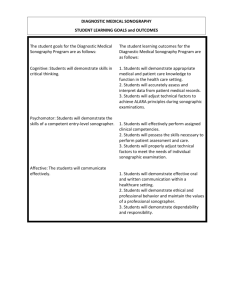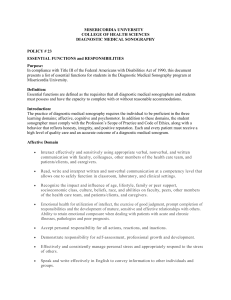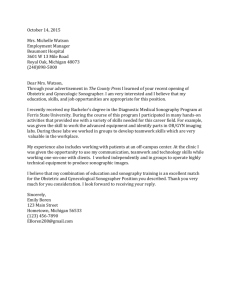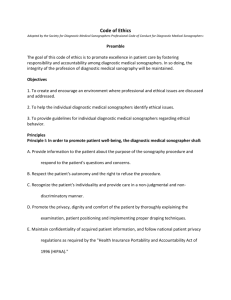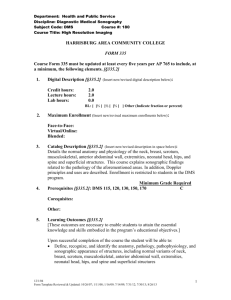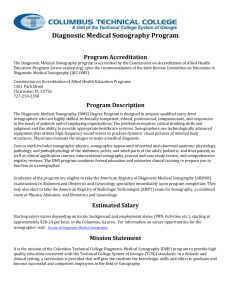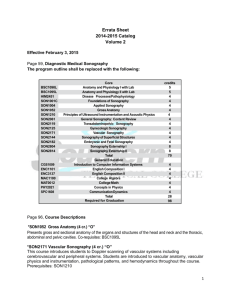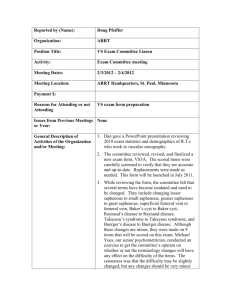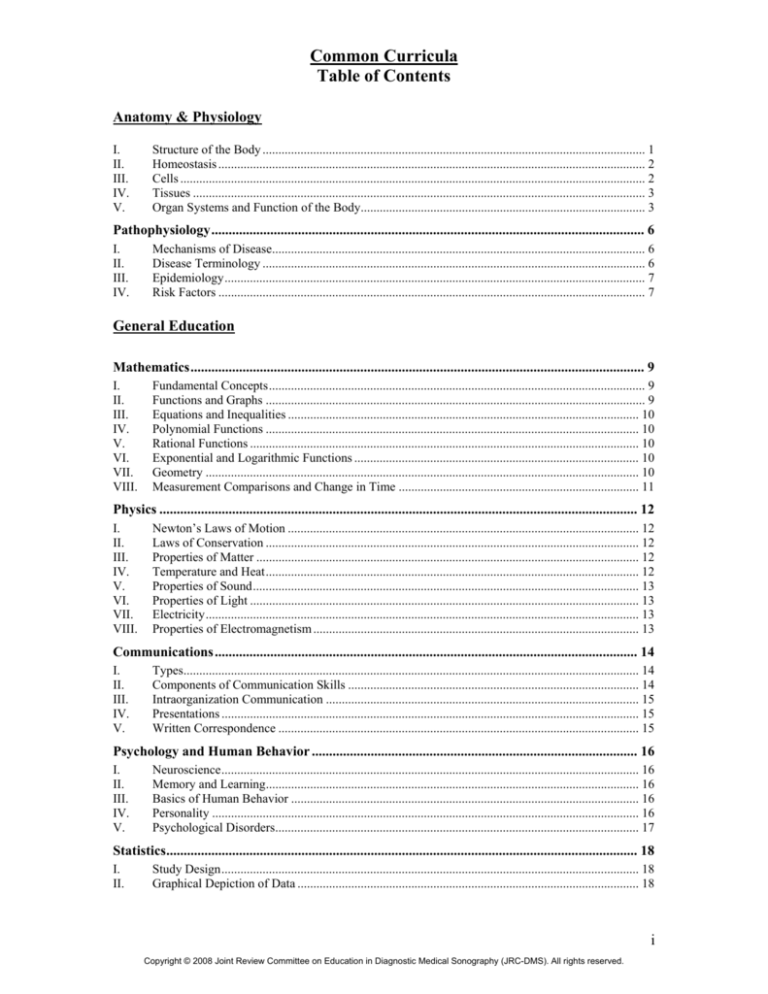
Common Curricula
Table of Contents
Anatomy & Physiology
I.
II.
III.
IV.
V.
Structure of the Body ......................................................................................................................... 1
Homeostasis ....................................................................................................................................... 2
Cells ................................................................................................................................................... 2
Tissues ............................................................................................................................................... 3
Organ Systems and Function of the Body.......................................................................................... 3
Pathophysiology ............................................................................................................................. 6
I.
II.
III.
IV.
Mechanisms of Disease...................................................................................................................... 6
Disease Terminology ......................................................................................................................... 6
Epidemiology ..................................................................................................................................... 7
Risk Factors ....................................................................................................................................... 7
General Education
Mathematics ................................................................................................................................... 9
I.
II.
III.
IV.
V.
VI.
VII.
VIII.
Fundamental Concepts ....................................................................................................................... 9
Functions and Graphs ........................................................................................................................ 9
Equations and Inequalities ............................................................................................................... 10
Polynomial Functions ...................................................................................................................... 10
Rational Functions ........................................................................................................................... 10
Exponential and Logarithmic Functions .......................................................................................... 10
Geometry ......................................................................................................................................... 10
Measurement Comparisons and Change in Time ............................................................................ 11
Physics .......................................................................................................................................... 12
I.
II.
III.
IV.
V.
VI.
VII.
VIII.
Newton’s Laws of Motion ............................................................................................................... 12
Laws of Conservation ...................................................................................................................... 12
Properties of Matter ......................................................................................................................... 12
Temperature and Heat ...................................................................................................................... 12
Properties of Sound .......................................................................................................................... 13
Properties of Light ........................................................................................................................... 13
Electricity ......................................................................................................................................... 13
Properties of Electromagnetism ....................................................................................................... 13
Communications .......................................................................................................................... 14
I.
II.
III.
IV.
V.
Types................................................................................................................................................ 14
Components of Communication Skills ............................................................................................ 14
Intraorganization Communication ................................................................................................... 15
Presentations .................................................................................................................................... 15
Written Correspondence .................................................................................................................. 15
Psychology and Human Behavior .............................................................................................. 16
I.
II.
III.
IV.
V.
Neuroscience .................................................................................................................................... 16
Memory and Learning...................................................................................................................... 16
Basics of Human Behavior .............................................................................................................. 16
Personality ....................................................................................................................................... 16
Psychological Disorders................................................................................................................... 17
Statistics........................................................................................................................................ 18
I.
II.
Study Design .................................................................................................................................... 18
Graphical Depiction of Data ............................................................................................................ 18
i
Copyright © 2008 Joint Review Committee on Education in Diagnostic Medical Sonography (JRC-DMS). All rights reserved.
Anatomy and Physiology
III.
IV.
V.
VI.
VII.
VIII.
Descriptive Statistics ........................................................................................................................ 18
Probability and Random Variables .................................................................................................. 19
Sampling Distributions .................................................................................................................... 19
Confidence Intervals ........................................................................................................................ 19
Hypothesis Testing........................................................................................................................... 19
Bivariate Data Analysis ................................................................................................................... 19
Information Technology ............................................................................................................. 20
I.
II.
III.
IV.
V.
Basic Computer Terminology .......................................................................................................... 20
Information Systems ........................................................................................................................ 20
Storage and Archiving ..................................................................................................................... 20
Communications .............................................................................................................................. 20
Electronic Searching ........................................................................................................................ 21
Medical Ethics and Law
I.
Medical Law .................................................................................................................................... 22
II.
Ethics ............................................................................................................................................... 23
III.
Patient Privacy and Confidentiality ................................................................................................. 23
IV.
Coding and Reimbursement ............................................................................................................. 24
V.
Third-party reimbursement .............................................................................................................. 24
VI.
Universal Coding System................................................................................................................. 24
Abbreviations ............................................................................................................................................... 25
Utilized References ...................................................................................................................................... 26
Patient Care
I.
Body Mechanics, Lifts, and Transfers ............................................................................................. 27
II.
Immobilization Techniques.............................................................................................................. 27
III.
Patient Assessment and Administration of Care .............................................................................. 28
IV.
Oxygen Therapy and Devices .......................................................................................................... 28
V.
Tubes, Lines, and Indwelling Catheters ........................................................................................... 28
VI.
Transducer Care ............................................................................................................................... 29
VII.
Infection Control .............................................................................................................................. 29
VIII. Isolation Techniques ........................................................................................................................ 29
IX.
Aseptic and Sterile Technique ......................................................................................................... 29
X.
Response to Medical Emergencies................................................................................................... 30
XI.
Contrast Media ................................................................................................................................. 30
XII.
Basic Pharmacology......................................................................................................................... 31
XIII. Professionalism ................................................................................................................................ 31
XIV. Critical Thinking .............................................................................................................................. 31
XV. Medical Terminology....................................................................................................................... 31
XVI. Patient Evaluation ............................................................................................................................ 32
XVII. Emergency Preparedness ................................................................................................................. 32
XVIII. Cultural Competence ....................................................................................................................... 32
Abbreviations ............................................................................................................................................... 33
Utilized References ...................................................................................................................................... 34
Sonographic Principles & Instrumentation
I.
II.
III.
IV.
Basic Principles and Wave Analysis ................................................................................................ 35
Propagation of Acoustic Waves through Tissues ............................................................................. 37
Sonographic Transducers and Sound Beams ................................................................................... 38
Principles of Pulse Echo Imaging .................................................................................................... 40
ii
Copyright © 2008 Joint Review Committee on Education in Diagnostic Medical Sonography (JRC-DMS). All rights reserved.
Common Curricula
Table of Contents
V.
Hemodynamic and Doppler Imaging ............................................................................................... 42
VI.
Sonographic Instrumentation ........................................................................................................... 44
VII.
Artifacts ........................................................................................................................................... 47
VIII. Quality Assurance/Quality Control of Sonographic Instruments ..................................................... 48
IX.
Bioeffects and Safety ....................................................................................................................... 49
Abbreviations ............................................................................................................................................... 52
Utilized References ...................................................................................................................................... 53
Work-Related Musculoskeletal Disorders (WRMSD)
I.
Ergonomics ...................................................................................................................................... 54
II.
Risk factors ...................................................................................................................................... 54
III.
Prevention Techniques ..................................................................................................................... 54
IV.
Ergonomic Design of Work Environment ....................................................................................... 55
V.
Physical Manifestations ................................................................................................................... 55
VI.
Symptoms ........................................................................................................................................ 56
VII.
Diagnosis and Treatment ................................................................................................................. 56
VIII. Impact of WRMSD .......................................................................................................................... 56
Utilized References ...................................................................................................................................... 57
iii
Copyright © 2008 Joint Review Committee on Education in Diagnostic Medical Sonography (JRC-DMS). All rights reserved.
Anatomy and Physiology
Rationale: Comprehensive knowledge of anatomy and physiology is a fundamental prerequisite
to medical sonographic imaging. The essential components of the study of an anatomy and
physiology curriculum are listed below.
1. Discuss the structural levels of organization, anatomical components, and physiology
2. Define terminology and relationships related to anatomical directions, planes, and body
cavities
3. Define homeostasis and its importance on the human body
4. Describe the anatomy and physiology of each of the organ systems of the body
I. Structure of the Body
A. Structural Levels of Organization
1. Chemical level
2. Cellular level
3. Tissues
4. Organs
5. Systems
B. Anatomic Position
1. Supine
2. Prone
C. Anatomic Directions
1. Superior/inferior
a. Cranial/caudal
2. Anterior/posterior
3. Medial/lateral
4. Proximal/distal
5. Superficial/deep
D. Planes or Body Sections
1. Sagittal
a. Midsagittal
b. Parasagittal
2. Coronal
3. Transverse
E. Body Cavities
1. Ventral
a. Thoracic cavity
1) Mediastinum
2) Pleural
b. Abdominopelvic cavity
1) Abdominal
1
Copyright © 2008 Joint Review Committee on Education in Diagnostic Medical Sonography (JRC-DMS). All rights reserved.
Anatomy and Physiology
2) Pelvic
3) Peritoneal/retroperitoneal
c. Abdominopelvic regions
1) Nine regions
a) Right and left hypochondriac regions
b) Epigastric region
c) Right and left lumbar regions
d) Umbilical region
e) Right and left iliac regions
f) Hypogastric region
2) Four quadrants
a) Right upper
b) Right lower
c) Left upper
d) Left lower
2. Dorsal
a. Cranial cavity
b. Spinal cavity
II. Homeostasis
A. Definition
B. Significance
III. Cells
A. Characteristics
1.
Size and shape
2.
Composition
3.
Structural parts of the cell
4.
Relationship of cell structure and function
B. Membranes
1.
Passive transport
2.
Active transport
3.
Cell transport and disease
C. Reproduction
1. DNA
2. DNA replications
3. Mitosis
4. Cell division
5. Genetic code
2
Copyright © 2008 Joint Review Committee on Education in Diagnostic Medical Sonography (JRC-DMS). All rights reserved.
Anatomy and Physiology
6. Changes in cell growth and reproduction
7. Inheritance and disease
IV. Tissues
A. Epithelial Tissue
B. Connective Tissue
C. Muscle Tissue
D. Nervous Tissue
E. Tissue Repair
V. Organ Systems and Function of the Body
A. Integumentary
1. Skin
2. Hair
3. Nails
4. Sense receptors
5. Sweat glands
6. Oil glands
B. Musculoskeletal
1. Bones
2. Joints
3. Muscles
4. Tendons and ligaments
5. Cartilage
C. Nervous
1. Brain
2. Spinal cord
3. Nerves
D. Cardiovascular (Circulatory)
1. Heart
2. Circulation
a. Systemic
b. Pulmonary
c. Hepatic portal
d. Fetal
3
Copyright © 2008 Joint Review Committee on Education in Diagnostic Medical Sonography (JRC-DMS). All rights reserved.
Anatomy and Physiology
3. Blood pressure
4. Pulse
E. Endocrine
1. Pituitary gland
2. Pineal gland
3. Hypothalamus
4. Thyroid gland
5. Parathyroid gland
6. Thymus
7. Adrenals
8. Pancreas
9. Ovaries
10. Testes
F. Lymphatic and Immune
1. Lymph nodes
2. Lymph vessels
3. Thymus
4. Spleen
5. Tonsils
G. Respiratory
1. Nose
2. Pharynx
3. Larynx
4. Trachea
5. Bronchi
6. Lungs
H. Digestive
1.
Primary organs
a. Mouth
b. Pharynx
c. Esophagus
d. Stomach
e. Small intestine
f. Large intestine
g. Rectum
h. Anal canal
2.
Secondary organs
a. Teeth
b. Salivary glands
c. Tongue
d. Liver
e. Gallbladder and bile ducts
4
Copyright © 2008 Joint Review Committee on Education in Diagnostic Medical Sonography (JRC-DMS). All rights reserved.
Anatomy and Physiology
f. Pancreas
g. Appendix
I. Urinary
1. Kidneys
2. Ureters
3. Urinary bladder
4. Urethra
J. Reproductive
1.
Female
a. Ovaries
b. Uterus
c. Fallopian tubes
d. Vagina
e. Vulva
2.
Male
a. Testes
b. Vas deferens
c. Epididymis
d. Urethra
e. Prostate
f. Seminal vesicles
g. Penis
h. Scrotum
5
Copyright © 2008 Joint Review Committee on Education in Diagnostic Medical Sonography (JRC-DMS). All rights reserved.
Anatomy and Physiology
Pathophysiology
Rationale: Sonographers require a comprehensive knowledge of anatomic versus physiologic
abnormalities to assist in the identification and diagnosis of disease. The study of
pathophysiology is a branch of pathology, the general study of disease. Disease can be described
as abnormality in body function that threatens well-being. The essential components of the study
of pathophysiology are listed below.
1.
2.
3.
4.
List and describe the basic mechanisms of disease and risk factors associated with disease
List and describe the categories of pathogenic organisms and how they cause disease
Distinguish between the terms benign and malignant as they apply to tumors
Outline the events of inflammatory response and explain its role in disease
I. Mechanisms of Disease
A. Infectious
1. Virus
2. Prions
3. Bacteria
4. Fungi
5. Protozoa
B. Neoplastic
1. Benign
2. Malignant
C. Degenerative/Multifactorial
1. Atherosclerosis
D. Inflammatory
E. Autoimmune
F. Others
1. Nutritional
2. Congenital versus acquired
3. Physical and chemical agents
II. Disease Terminology
A. Signs
B. Symptoms
6
Copyright © 2008 Joint Review Committee on Education in Diagnostic Medical Sonography (JRC-DMS). All rights reserved.
Anatomy and Physiology
C. Syndrome
D. Acute
E. Chronic
F. Etiology
G. Idiopathic
H. Iatrogenic
I. Communicable
J. Pathogenesis
K. Incubation
L. Remission
M. Primary
N. Metastasis
O. Morbidity
P. Mortality
III. Epidemiology
A. Endemic
B. Epidemic
C. Pandemic
IV. Risk Factors
A. Genetic
B. Age
C. Lifestyle
7
Copyright © 2008 Joint Review Committee on Education in Diagnostic Medical Sonography (JRC-DMS). All rights reserved.
Anatomy and Physiology
D. Stress
E. Environmental
F. Preexisting Condition
8
Copyright © 2008 Joint Review Committee on Education in Diagnostic Medical Sonography (JRC-DMS). All rights reserved.
General Education
Mathematics
Rationale: In order for sonographers to be successful in applying knowledge of physics, a
solid background in mathematics is essential. The study of physics, acoustic physics, and
application for measurement and quantitative analysis of anatomical structures using
sonography requires a prerequisite knowledge of mathematics. The essential components of a
mathematics curriculum are listed below.
1.
2.
3.
4.
5.
6.
Perform operations of algebraic expressions
Graph linear and quadratic functions
Solve equations and inequalities algebraically, and graphically
Graph polynomial, rational, algebraic, exponential, and logarithmic functions
Solve exponential and logarithmic equations
Describe fundamental geometric concepts and formulas
I. Fundamental Concepts
A. Real Numbers
B. Basic Rules of Algebra
C. Radicals and Rational Exponents
D. Polynomials
E. Factoring
F. Ordinal versus Linear Number System
II. Functions and Graphs
A. Functions
B. Combinations of Functions
C. Inverses of Functions
D. Graphs of Linear Functions
E. Graphs of Quadratic Functions
9
Copyright © 2008 Joint Review Committee on Education in Diagnostic Medical Sonography (JRC-DMS). All rights reserved.
General Education
III. Equations and Inequalities
A. Intercepts and Zeros of Functions
B. Solving Equations
1. Algebraically
2. Graphically
C. Solving Inequalities
1. Algebraically
2. Graphically
IV. Polynomial Functions
A. Quadratic Functions
B. Polynomial Functions of Higher Degree
C. Synthetic Division
D. Real Zeros of Polynomials
V. Rational Functions
A. Partial Fractions
VI. Exponential and Logarithmic Functions
A. Graphs
B. Equations
C. Models
VII. Geometry
A. Fundamental Concepts and Formulas
1. Linear measurements
2. Circles and spheres
a. Radius
b. Diameter
c. Circumference
10
Copyright © 2008 Joint Review Committee on Education in Diagnostic Medical Sonography (JRC-DMS). All rights reserved.
General Education
d. Area
e. Orthogonal planes
3. Volumes
a. Spherical
b. Ellipsoidal
c. Cylindrical
b. Pyramidal and conical
c. Irregular volumes
d. Methods of measuring volumes
1) Calculation from linear perpendicular measurements
2) Calculation by Simpson’s Rule
VIII. Measurement Comparisons and Change in Time
A. Ratios
11
Copyright © 2008 Joint Review Committee on Education in Diagnostic Medical Sonography (JRC-DMS). All rights reserved.
General Education
Physics
Rationale: Mastery of general physics is an essential prerequisite to the study of acoustic
physics. The essential components of a physics curriculum are listed below.
1.
2.
3.
4.
5.
Discuss Newton’s laws of motion
Describe the properties of solids, liquids, and gases
Identify the characteristics of sound and the wave properties of sound
Describe the properties of heat and light
Discuss the behavior of electric charges and electromagnetic charges
I. Newton’s Laws of Motion
A. Inertia
B. Acceleration
C. Reciprocal Action
II. Laws of Conservation
A. Momentum
B. Energy
C. Angular Momentum
III. Properties of Matter
A. Solids
B. Liquids
C. Gases
IV. Temperature and Heat
A. Thermal Energy and Thermodynamics
B. Heat Transfer
12
Copyright © 2008 Joint Review Committee on Education in Diagnostic Medical Sonography (JRC-DMS). All rights reserved.
General Education
V. Properties of Sound
A. Waves
B. Frequency Ranges
1. Infrasound
2. Audible
3. Ultrasound
VI. Properties of Light
A. Color
B. Reflection and Refraction
C. Emission
VII. Electricity
A. Charge and Force
B. Current and Ohm’s Law
VIII. Properties of Electromagnetism
A. Waves
B. Frequency Spectrum
13
Copyright © 2008 Joint Review Committee on Education in Diagnostic Medical Sonography (JRC-DMS). All rights reserved.
General Education
Communications
Rationale: Sonographers must be able to effectively communicate with patients, the public,
and the healthcare team. The essential components of a communications curriculum are listed
below.
1.
2.
3.
4.
5.
Differentiate the various types of communication
Relate the effectiveness of good interpersonal skills
Discuss communication skills required within an organization
Describe the process and skills for creation and delivery of quality presentations
Demonstrate ability to compose formal written documents
I. Types
A. Verbal
1. Vocal characteristics
2. Vocabulary
B. Written
1. Formal
2. Informal
C. Non-Verbal
1. Expressive behaviors
2. Body language
D. Listening
1. Passive
2. Active
II. Components of Communication Skills
A. Cognition
B. Emotion
C. Persuasion
D. Impact
E. Communication Barriers
14
Copyright © 2008 Joint Review Committee on Education in Diagnostic Medical Sonography (JRC-DMS). All rights reserved.
General Education
III. Intraorganization Communication
A. Direction of Communication
1. Top-down
2. Bottom-up
3. Side-to-side
B. Team Development
1. Stages of development
2. Member responsibilities
C. Conflict
1. Contributing factors
2. Resolution
IV. Presentations
A. Audience
1. One-to-one
2. Small group
3. Large group
B. Preparation
1. Goals for audience
2. Delivery format
3. Visual aids
4. Content
C. Delivery
1. Verbal
2. Non-verbal
V. Written Correspondence
A. Formal
B. Informal
C. Reports
D. Resume/Cover Letter
15
Copyright © 2008 Joint Review Committee on Education in Diagnostic Medical Sonography (JRC-DMS). All rights reserved.
General Education
Psychology and Human Behavior
Rationale: Sonographers require an understanding of the effects of personality, age, gender,
culture, and conditions on human behavior in order to effectively interact with patients and
the healthcare team. The essential components of a psychology curriculum are listed below.
1. List the physiological, cognitive, and affective foundations of behavior
2. Define the social basis for behavior
3. Discuss various personality traits
I. Neuroscience
A. Nervous System
B. Functional Anatomy
C. Sensory Processes
II. Memory and Learning
A. Developmental Stages
B. Theories of Learning
III. Basics of Human Behavior
A. Motivation
B. Emotion
C. Sensation and Perception
D. Attachment, Morality, Identity
E. Gender and Identity
IV. Personality
A. Attitudes and Attribution
B. Impressions and Influences
16
Copyright © 2008 Joint Review Committee on Education in Diagnostic Medical Sonography (JRC-DMS). All rights reserved.
General Education
C. Adaptation
D. Culture
V. Psychological Disorders
A. Categories
B. Treatments
17
Copyright © 2008 Joint Review Committee on Education in Diagnostic Medical Sonography (JRC-DMS). All rights reserved.
General Education
Statistics
Rationale: Sonographers must interpret data relevant to the profession. An understanding of
statistical methodology and terminology is important to enhance critical thinking and for
continued professional growth. The essential components of a statistics curriculum are listed
below.
1.
2.
3.
4.
Describe methods of study design
Evaluate a variety of graphs utilized to plot statistical data
Define commonly used statistical terminology
Analyze statistical data in professional journals and publications
I. Study Design
A. Types of Data
B. Sampling
C. Surveys and Observational Studies
D. Comparative Studies
II. Graphical Depiction of Data
A. Frequency Distributions
B. Bar Charts
C. Pie Charts
D. Histograms
E. Dot Plots
F. Stem Plots
III. Descriptive Statistics
A. Measures of Central Tendency
B. Measures of Variability
18
Copyright © 2008 Joint Review Committee on Education in Diagnostic Medical Sonography (JRC-DMS). All rights reserved.
General Education
IV. Probability and Random Variables
A. Relative Frequency
B. Basic Properties
C. Estimating Probabilities Empirically
V. Sampling Distributions
A. Normal
B. Gaussian
C. Chi-square
VI. Confidence Intervals
A. Point Estimation
B. Population Mean
C. Population Proportion
VII. Hypothesis Testing
A. Test Procedures
B. Testing Errors
VIII. Bivariate Data Analysis
A. Scatter Plots
B. Pearson Correlation Coefficient
C. Simple Linear Regression
19
Copyright © 2008 Joint Review Committee on Education in Diagnostic Medical Sonography (JRC-DMS). All rights reserved.
General Education
Information Technology
Rationale: Sonographers effectively use computer technology to perform diagnostic medical
sonography. Application of computer basics is essential in understanding sonographic
instrumentation. Information management requires a working knowledge of computer
technology. The essential components of an information technology curriculum are listed
below.
1.
2.
3.
4.
Define basic computer terminology
Discuss use of information technology in healthcare management
List devices used for storage in diagnostic imaging
Discover communication mechanisms used for electronic searches
I. Basic Computer Terminology
A. Hardware Components
B. Software
1. Operating systems
2. Web browser
3. Word processor
4. Spreadsheets
5. Database management
6. Presentation software
7. Image editing
II. Information Systems
A. File Management
B. Electronic Record System
III. Storage and Archiving
IV. Communications
A. Intranet
B. Internet
20
Copyright © 2008 Joint Review Committee on Education in Diagnostic Medical Sonography (JRC-DMS). All rights reserved.
General Education
V. Electronic Searching
A. Search Engines
B. Databases
C. Evaluation of Information
21
Copyright © 2008 Joint Review Committee on Education in Diagnostic Medical Sonography (JRC-DMS). All rights reserved.
Medical Ethics and Law
Rationale: Sonographers must be knowledgeable of medical law as it relates to their
professional scope of practice. Exposure to medicolegal consequences are minimized
through education in legal process, principles of decision making, ethical dilemmas, HIPAA
(Health Insurance Portability and Accountability Act), and coding and reimbursement.
Professionalism is demonstrated through practice according to nationally-recognized scopes
of practice and codes of ethics. The essential components of a medical law and ethics
curriculum are listed below.
1. Discuss the legal process and types of law
2. Describe best practices to avoid legal consequences and procedures for reporting
medical errors
3. Define key terminology related to ethics and principles of ethical decisions
4. Discuss the Patient Care Partnership (Patient’s Bill of Rights)
5. Discuss compliance regulations relating to patient privacy and confidentiality
6. Describe the healthcare coding and reimbursement system
7. Analyze consequences for non-compliance to coding and reimbursement policies
I. Medical Law
A. Definition of Law
B. Types of Law
1. Substantive versus procedural law
2. Common
3. Civil
4. Contract
5. Criminal
6. Tort
a. Unintentional
b. Intentional
C. The Process From Claim to Outcome
1. Filing complaint
2. Discovery
a. Depositions
b. Document request
3. Court
a. Trial
b. Appellate
c. Supreme
D. Terminology
1. Respondeat superior
2. Res ipsa loquitur
22
Copyright © 2008 Joint Review Committee on Education in Diagnostic Medical Sonography (JRC-DMS). All rights reserved.
Medical Ethics and Law
E. Risk Management
1. Medical malpractice liability coverage
2. Documentation
3. Scope of practice
4. Adherence to employment policies and procedures
5. Informed consent
F. Patient Care Partnership (Patient’s Bill of Rights)
G. Regulatory Standards
1. Agencies
2. Guidelines
II. Ethics
A. Key Concepts
1. Ethics
2. Values
3. Morals
4. Codes of ethics and conduct
5. Ethical problems
a. Ethical dilemma
b. Ethical dilemma of justice
c. Ethical distress
d. Locus of authority issues
B. Terminology
1. Autonomy
2. Justice
3. Fidelity
4. Beneficence
5. Nonmalfeasance
6. Veracity
7. Paternalism
8. Utilitarianism
9. Deontology
III. Patient Privacy and Confidentiality
A. Health Insurance Portability and Accountability Act (HIPAA)
1. Overview of purpose
a. Confidentiality
b. Patient health information
c. Electronic transmission of healthcare transactions
23
Copyright © 2008 Joint Review Committee on Education in Diagnostic Medical Sonography (JRC-DMS). All rights reserved.
Medical Ethics and Law
d. Computer integrity
B. Compliance Practices
IV. Coding and Reimbursement
A. Governing Bodies
1. Center for Medicare and Medicaid Services (CMS)
V. Third-party reimbursement
VI. Universal Coding System
A. International classification of diseases (ICD-9)
1. Mechanism of tracking diseases
2. Symptom and diagnosis codes
B. Healthcare common procedure coding system (HCPCS)
1. Uniform coding system
2. Current procedural terminology (CPT) codes
C. Local Carrier Determination (LCD) Review Policies
1. Accreditation
2. Personnel certification
D. Process of Post-Review Audits
E. Consequences of Fraud
F. Applicable ‘Whistleblower” Laws
1. Local
2. Federal
24
Copyright © 2008 Joint Review Committee on Education in Diagnostic Medical Sonography (JRC-DMS). All rights reserved.
Medical Ethics and Law
ABBREVIATIONS
C
CMS
CPT
Center for Medicare and Medicaid Services
Current Procedural Terminology
H
HCPCS
HIPAA
Healthcare Common Procedure Coding System
Health Insurance Portability and Accountability Act
I
ICD-9
International Classification of Diseases
L
LCD
Local Carrier Determination
25
Copyright © 2008 Joint Review Committee on Education in Diagnostic Medical Sonography (JRC-DMS). All rights reserved.
Medical Ethics and Law
UTILIZED REFERENCES
Craig M. Essentials of Sonography and Patient Care, 2nd ed. St.Louis, MO: Elsevier
Saunders; 2006.
Dandry Aiken, T. Legal and Ethical Issues in Health Occupations. Saunders; 2002.
Nuclear Medicine Curriculum Guide.
26
Copyright © 2008 Joint Review Committee on Education in Diagnostic Medical Sonography (JRC-DMS). All rights reserved.
Patient Care
Rationale: Sonographers assess clinical history, current medical condition, provide high quality
patient care, respond to emergency situations, demonstrate awareness of infection control
techniques, and provide a safe environment for both the patient and health care team. Oral,
written, and non-verbal communication must adhere to the prescribed professional standards.
The essential components of a patient care curriculum are listed below.
1. Demonstrate patient transfer and immobilization techniques with consideration to safety
of patient and self
2. Discuss the use and care for intravenous lines, catheters, percutaneous drains, and oxygen
administration devices
3. Discuss transducer preparation, insertion, and disinfectant techniques
4. Explain the importance of infection control, practicing proper techniques, and
management and proper disposal of contaminated and biohazard materials
5. Describe isolation precautions and aseptic techniques
6. Discuss appropriate responses to condition specific medical emergencies
7. Identify various contrast media used with sonography and medical imaging procedures
and their associated risks and contraindications
8. List basic pharmacological agents that may be used with sonographic procedures,
examinations, and emergency situations
9. Analyze the significance of appropriate professional behaviors
10. Discuss critical thinking and its application to the healthcare environment
11. Define and apply medical terms
12. Demonstrate effective acquisition and reporting of patient history, physical and
sonographic findings
13. Discuss the components of an effective emergency preparedness plan
14. Demonstrate key skills of cultural competence
I. Body Mechanics, Lifts, and Transfers
A. Proper Body Mechanics
B. Lifting
C. Wheelchair Transfers
D. Stretcher/Bed Transfers
II. Immobilization Techniques
A. Age Specific
1. Pediatric
2. Adult
B. Mechanisms of Immobilization
27
Copyright © 2008 Joint Review Committee on Education in Diagnostic Medical Sonography (JRC-DMS). All rights reserved.
Patient Care
III. Patient Assessment and Administration of Care
A. Vital Signs
B. Special Considerations
1. Sedated
2. Unconscious
3. Cognitively impaired
4. Uncooperative
5. Ventilated
C. Compassionate Care
D. Patient Directives
IV. Oxygen Therapy and Devices
A. Types
1. Nasal cannula
2. Nasal catheter
3. Face mask
4. Oxygen tent
5. Pulse oximeter
6. Oxygen cylinders
B. Precautions
V. Tubes, Lines, and Indwelling Catheters
A. Intravenous
B. Urinary Catheters
C. Wound Drainage
D. Nasogastric Tube
E. Gastrostomy Tube
F. Endotracheal Tube
G. Chest Tube
H. Percutaneous Catheter
28
Copyright © 2008 Joint Review Committee on Education in Diagnostic Medical Sonography (JRC-DMS). All rights reserved.
Patient Care
I. Fetal Monitor
J. Assist Devices
K. Other
VI. Transducer Care
A. Types
B. Preparation, Cleaning, Disinfection, and Storage
VII. Infection Control
A. Nosocomial Infections
B. Signs and Symptoms
C. Precautions
1. Standard precautions
a. Hand hygiene
b. Personal protective equipment
1) Masks
2) Eye protection
3) Gloves
4) Aprons/gowns
c. Sharps management
d. Biohazards
2. Transmission based precautions
a. Airborne
b. Droplet
c. Contact
VIII. Isolation Techniques
A. General
B. Reverse Isolation
IX. Aseptic and Sterile Technique
A. Medical, Surgical Asepsis
1. Proper attire
29
Copyright © 2008 Joint Review Committee on Education in Diagnostic Medical Sonography (JRC-DMS). All rights reserved.
Patient Care
B. Establish and Maintain Sterile Field
C. Hand Wash Technique
D. Sterile Environments
1. Intensive care unit (ICU)
2. Operating room (OR)
X. Response to Medical Emergencies
A. First Aid
B. Emergency Cart
C. Head injuries
D. Shock
E. Diabetic Crisis
F. Respiratory Distress
1. Respiratory arrest
G. Cardiac Arrest
1. Cardiopulmonary Resuscitation (CPR)
H. Cardiovascular Event
1. Stroke
2. Transient ischemic attack (TIA)
I. Minor Emergencies
1. Nausea and vomiting
2. Syncope
3. Seizures
J. Wounds
1. Hemorrhage
2. Burns
3. Dehiscence
4. Ulcerations
XI. Contrast Media
A. Types
30
Copyright © 2008 Joint Review Committee on Education in Diagnostic Medical Sonography (JRC-DMS). All rights reserved.
Patient Care
1. Intravenous injections
2. Other
B. Risks and Contraindications
C. Adverse Reactions and Patient Management
XII. Basic Pharmacology
XIII. Professionalism
A. Professional Standards of Practice
B. Code of Ethics
C. Professional Image
1. Appearance and hygiene
2. Positive attitude
D. Non-Discrimination
E. Respect for Patient Dignity
F. Barriers to Employment
G. Continuous Quality Improvement (CQI)
XIV. Critical Thinking
A. Problem Solving and Decision Making
XV. Medical Terminology
A. Word Roots, Prefixes, and Suffixes
B. Definitions
C. Pronunciations
D. Abbreviations
31
Copyright © 2008 Joint Review Committee on Education in Diagnostic Medical Sonography (JRC-DMS). All rights reserved.
Patient Care
XVI. Patient Evaluation
A. Patient Identification
1. Double identifier
2. Time out
3. Hand off
B. Informed Consent
C. Pertinent Medical History
D. Critical Analysis of Patient History and Physical Findings
1. Medical record
2. Medical chart
3. Correlative diagnostic assessment reports
E. Documentation of History and Sonographic Findings
1. Technical notes
2. Oral case presentation
XVII. Emergency Preparedness
XVIII. Cultural Competence
A. Awareness of One’s Own Cultural World View
B. Knowledge of Different Cultural Practices and World Views
C. Attitude Toward Cultural Differences
D. Cross-Cultural Skills
32
Copyright © 2008 Joint Review Committee on Education in Diagnostic Medical Sonography (JRC-DMS). All rights reserved.
Patient Care
ABBREVIATIONS
C
CPR
CQI
Cardiopulmonary Resuscitation
Continuous Quality Improvement
I
ICU
Intensive Care Unit
O
OR
Operating Room
T
TIA
Transient Ischemic Attack
33
Copyright © 2008 Joint Review Committee on Education in Diagnostic Medical Sonography (JRC-DMS). All rights reserved.
Patient Care
UTILIZED REFERENCES
Commission on Accreditation of Allied Health Education Programs (CAAHEP) Standards and
Guidelines for Diagnostic Medical Sonography.
Craig M. Essentials of Sonography and Patient Care, 2nd ed. St.Louis, MO: Elsevier Saunders;
2006.
Diagnostic Ultrasound Clinical Practice Standards. Plano, TX: Society of Diagnostic Medical
Sonography, 2008.
Code of Ethics for the Profession of Diagnostic Medical Sonography. Plano, TX: Society of
Diagnostic Medical Sonography, 2008.
St. John Ambulance First Aid on the Scene; 2000.
Torres, Norcutt, Dutton. Basic Medical Techniques and Patient Care in Imaging Technology, 6th
ed. Lippincott Williams & Wilkins; 2003.
The SCAN. Plano, TX: SDMS Educational Foundation, 2008.
http://cardup.org/english/images/ocp.pdf Canadian Association of Registered Diagnostic
Ultrasound Professionals (CARDUP) National Competency Profiles.
34
Copyright © 2008 Joint Review Committee on Education in Diagnostic Medical Sonography (JRC-DMS). All rights reserved.
Sonographic Physics & Instrumentation
Rationale: Sonographers apply principles of ultrasound in the operation of medical sonographic
equipment to produce a sonogram. Knowledge of the interaction of ultrasound with tissue is
important for image optimization, acquisition and interpretation of sonographic images, and
critical to the accurate diagnosis of disease.
1. Describe sound waves, propagation of ultrasound through tissue, reflection, refraction,
and scattering
2. Explain transducer technology, and discuss the advantages and limitations of the various
types
3. Discuss the basic features of medical sonographic equipment, including operator controls
and image processing
4. Describe the role of advanced scanning features, including harmonics, coded excitation,
and compounding
5. Explain how pulsed Doppler, color flow imaging, and amplitude imaging is achieved
6. Recognize and describe image artifacts and techniques to minimize or eliminate them
7. Describe the importance of performance, safety, and output measurements and standards
I. Basic Principles and Wave Analysis
A. General Principles
1. Scientific notation
2. Metric notation
3. Common units
a. Time – sec
b. Power – watts
c. Work – joule
d. Acoustic impedance – rayls
4. Measurement dimensions
a. Distance
1) Linear
2) Circumference
b. Area
c. Volume
B. Nature of Sound
1. Definition of sound
a. Wave classifications
1) Electromagnetic
2) Mechanical
a) Longitudinal
b) Transverse
b. Wave anatomy
1) Cycle
a) Phase
b) Frequency
35
Copyright © 2008 Joint Review Committee on Education in Diagnostic Medical Sonography (JRC-DMS). All rights reserved.
Sonographic Physics & Instrumentation
c) Period
d) Wavelength
2) Compression
3) Rarefaction
4) Nodes/antinodes
2. Acoustic spectrum
a. Infrasound
b. Audible sound
c. Ultrasound
3. Sound wave interaction/interference
a. Huygen's principle
b. Constructive
c. Destructive
d. Beat frequency
4. Types of waves
a. Continuous wave
b. Pulse wave characteristics, units, and ranges
1) Pulse repetition frequency
2) Pulse repetition period
3) Pulse duration
4) Spatial pulse length
5) Duty factor
C. Wave Characteristics
1. Definition of terms
a. Propagation speed
b. Frequency
1) Typical ranges
2) Penetration
c. Wavelength
d. Acoustic impedance
2. Relationship between terms
3. Common units of terms
4. Acoustic variable
a. Density
b. Pressure
c. Temperature
d. Particle motion
D. Properties of Acoustic Waves
1. Amplitude
2. Pressure
3. Power
4. Intensity
E. Decibels
1. Definition
36
Copyright © 2008 Joint Review Committee on Education in Diagnostic Medical Sonography (JRC-DMS). All rights reserved.
Sonographic Physics & Instrumentation
a. Related to intensity
b. Related to amplitude
2. Examples corresponding to half value layers
II. Propagation of Acoustic Waves through Tissues
A. Speed of Sound
1. Average speed in tissues
2. Range of propagation speeds in the body
a. Air
b. Water
c. Muscle
d. Fat
e. Various parenchyma
f. Bone
g. Average for soft tissue
3. Media properties
a. Elasticity
b. Density
c. Compressibility/bulk modulus
d. Relationship between properties
B. Reflection
1. Definition of reflection
2. Specular reflector and highlights
a. Interface size and contour
b. Dependence on angle
c. Dependence on acoustic impedance mismatch
1) Definition of acoustic impedance
2) Common units
3) Determine ease of reflection versus transmission
3. Scatterer
a. Definition of scattering
b. Frequency dependence
c. Interface contour
d. Contrast media
C. Refraction
1. Definition of refraction
2. Snell’s law
D. Attenuation
1. Definition of attenuation
2. Sources of attenuation
a. Reflection/Scattering
b. Refraction
37
Copyright © 2008 Joint Review Committee on Education in Diagnostic Medical Sonography (JRC-DMS). All rights reserved.
Sonographic Physics & Instrumentation
3.
4.
5.
6.
c. Interference
d. Diffusion
e. Absorption
Dependence on frequency
Typical values in soft tissue
Relationship between coefficient, depth, frequency
Effects on images
a. Frequency versus spatial resolution
b. Penetration versus spatial resolution
E. Harmonics
1. Tissue harmonics versus contrast harmonics
2. Generation of odd or even multiples of original frequency wave
3. Effect of high pressure area on sound wave
4. System requirements
a. Wide dynamic range
b. Transmitter
c. Bandwidth/passband limitations
5. Advantages and limitations
6. Clinical applications
III. Sonographic Transducers and Sound Beams
A. Piezoelectric Properties
1. Definition of piezoelectric effect
2. Curie point
3. Dipole alignment process
4. Piezoelectric materials
B. Transducer Construction and Characteristics
1. Transducer housing
a. Protective
b. Orientation
c. Care
2. Backing material
a. Insulation
b. Damping
1) Relationship of damping, pulse length, axial resolution, sensitivity
2) Passive versus dynamic damping
3. Matching layer
a. Purpose of matching layer
b. Relationship to wavelength, pulse length, sensitivity
4. Crystal/Element
a. Resonant, operating versus nominal frequency
b. Dependence of crystal thickness to resonance frequency
c. Frequency characteristics
38
Copyright © 2008 Joint Review Committee on Education in Diagnostic Medical Sonography (JRC-DMS). All rights reserved.
Sonographic Physics & Instrumentation
1) Bandwidth
a) Narrow versus broad bandwidth
b) Effect of damping
c) Q factor
C. Sound Beam Formation and Beam Shape
1. Definition of near field/Fresnel zone
a. Length of near field
1) Relationship to transducer frequency and crystal diameter
b. Shape of near field
1) Beam width
2) Natural focus
2. Definition of far field/Fraunhofer zone
a. Shape of far field
1) Relationship to transducer frequency and crystal diameter
3. Focused beam
a. Definition of focal plane, focal point, focal distance, focal zone
1) Maximum versus minimal areas of beam intensity
b. Method of focusing
1) Single element/mechanical transducers
2) Multi-element/dynamic transducers
c. Clinical uses with variable focuses
d. Interference phenomena
1) Huygen's principle
2) Diffraction (divergence)
3) Bandwidth
4. Pressure profiles
a. Identify axial, transverse, and polar pressure profiles
b. Relationship between bandwidth and each profile
c. Axial profile labeling
1) Pressure axis
2) Central beam axis
3) Near field
4) Far field
5) Application to assess near field and far field fluctuations
d. Transverse profile labeling
1) Pressure axis
2) Beam width axis
3) Distance from transducer axis
4) Application to provide beam diameter information
e. Polar profile labeling
1) Pressure axis
2) Angle theta
3) Main lobe
4) Side lobe
5) Application to provide information about energies outside of main beam
39
Copyright © 2008 Joint Review Committee on Education in Diagnostic Medical Sonography (JRC-DMS). All rights reserved.
Sonographic Physics & Instrumentation
D. Axial Resolution
1. Dependence on spatial pulse length/ pulse duration, damping, bandwidth
2. Relationship to transducer frequency
3. Numerical example
E. Lateral Resolution
1. Dependence on beam width, transducer frequency, transducer size, focal
characteristics
2. Relationship from transducer face
F. Slice Thickness or Elevational Resolution
1. Dependence on beam width, focal characteristics, and frequency
2. Relationship to lateral and axial resolution
G. Transducer Types
1. Mechanical construction/operation
a. Contact
b. Liquid-path
2. Multiple element construction
a. Linear array
b. Curved array
c. Annular array
d. Multi-dimensional array
3. Electronic operation
a. Sequenced
b. Phased/simultaneous
c. Annular/hybrid
d. Multi-dimensional
e. Beam steering
1) Transmission time delays
2) Reception time delays
f. Beam focusing
1) Time delays
2) Dynamic aperture
g. Firing variations
1) Apodization
2) Subdicing
4. Emerging technologies
H. Transducer Care and Maintenance
1. Effects of alcohol, autoclave, and physical damage
2. Proper cleansing routine
IV. Principles of Pulse Echo Imaging
A. A-mode
40
Copyright © 2008 Joint Review Committee on Education in Diagnostic Medical Sonography (JRC-DMS). All rights reserved.
Sonographic Physics & Instrumentation
1. Information displayed on image
a. Amplitude, depth/time
2. Advantages and disadvantages
3. Clinical applications
B. M-mode
1. Information displayed on image
a. Amplitude, depth, time
2. Advantages and disadvantages
3. Clinical applications
C. B-mode
1. Information displayed on image
a. Amplitude, depth
2. Advantages and disadvantages
3. Clinical applications
D. Volumetric Scanning Modes
1. Definition of voxel
2. Information displayed on image
3. Orthogonal planes
4. Advantages and disadvantages
5. Clinical applications
E. Scanning Speed Limitations
1. Definition of range equation
2. Real-time systems-relationships between
a. Pulse repetition frequency
b. Frame rate
c. Number of lines per frame
d. Number of focal regions
e. Field of view or sector angle
f. Image depth/penetration
g. Spatial resolution
h. Temporal resolution
F. System Controls
1. Purpose and definition
a. Freeze
b. Print
c. Depth/field of view (FOV)
d. Focus
e. Overall gain
f. Time gain compensation (TGC)
g. Transducer frequency selection
1) Examination presets
h. Calipers
41
Copyright © 2008 Joint Review Committee on Education in Diagnostic Medical Sonography (JRC-DMS). All rights reserved.
Sonographic Physics & Instrumentation
i.
j.
k.
l.
m.
n.
o.
Power/Mechanical Index (MI)/Thermal Indices (TI)
Cine loop
Harmonics
Compound imaging
Extended field of view
Scan modes
Emerging technologies
V. Hemodynamic and Doppler Imaging
A. Hemodynamics
1. Factors that influence blood flow
a. Cardiac function
b. Compliance
c. Muscle tone
d. Vessel branching patterns and dimensions
e. Luminal vessel diameter
2. Pressure gradient
a. Relationship between heart stroke volume, heart rate, blood volume
b. Dependence on flow and resistance
c. Effect of peripheral resistance
d. Sources of resistance
3. Hemodynamic resistance
a. Blood viscosity
b. Friction
c. Inertia
4. Poiseuille’s Law
a. Relationship between pressure, flow volume, and resistance
b. Effect of vessel radius to velocity and flow volume
c. Effects of temperature, exercise, and pharmacologics
1) Specific to various systems
5. Bernoulli’s equation
a. Relationship between velocity and pressure
6. Flow patterns
a. Steady flow
b. Pulsatile flow
c. High resistance
d. Low resistance
e. Laminar
f. Turbulent flow
1) Reynolds number
2) Bruit
f. Effects of stenosis on flow characteristics
g. Effects of peripheral resistance
7. Venous resistance
a. Hydrostatic pressure
42
Copyright © 2008 Joint Review Committee on Education in Diagnostic Medical Sonography (JRC-DMS). All rights reserved.
Sonographic Physics & Instrumentation
b.
c.
d.
e.
f.
g.
Effects of respiration
Muscle pump
Gravitational pressure
Incompetency
Fistula formation
Pressure versus volume effects
B. Doppler Physical Principles
1. Doppler effect
a. Principle as related to sampling red blood cell movement
b. Doppler equation
2. Factors influencing the magnitude of the Doppler shift frequency
a. Range of the Doppler shift frequency
b. Effects of beam angle, transmitted frequency
c. Relationship between frequency shift and flow velocity, flow direction
d. Relationship between blood pressure and blood volume
C. Doppler Instruments
1. Definition of continuous wave
a. Range ambiguity
b. Spectral appearance
c. Advantages and disadvantages
2. Definition of pulsed-wave Doppler
a. Range resolution
b. Nyquist limit
c. Advantages and disadvantages
3. Duplex instruments
a. Definition
b. Basic principles
c. Instrumentation
1) Receiver
2) Demodulator
a) Quadrature phase detector
3) Wall filter
4) Directional knobs
4. Spectral analysis
a. Appearance on the spectral display
1) Flow direction
2) Flow velocity
3) Velocity profiles
a) Plug
b) Turbulent
c) Laminar
b. Waveform magnitude or brightness
1) Fast Fourier transform (FFT)
c. Qualitative versus Quantitative evaluation
43
Copyright © 2008 Joint Review Committee on Education in Diagnostic Medical Sonography (JRC-DMS). All rights reserved.
Sonographic Physics & Instrumentation
D. Color Flow Imaging
1. Sampling methods
a. PW Doppler
b. RBC sampling
c. Tissue sampling
2. Display of Doppler information
a. Flow direction
b. Average velocity
c. Velocity maps
d. Angle dependence
3. Advantages and disadvantages
4. Instrumentation
a. Autocorrelation
1) Time domain processing
2) Dwell time
3) Color sensitivity
b. Relationship between color box size and frame rate
1) Ensemble length/packet size/pulse packet
2) Line density
3) Depth of penetration
c. Color maps
1) Hue
2) Saturation
3) Brightness/luminance/intensity
E. Color Power/Energy Mode
1. Displayed information – formats
a. Flow direction
b. Displayed velocity
c. Velocity maps
d. Angle independence
2. Advantages and disadvantages
VI. Sonographic Instrumentation
A. System Components
1. Beam former
2. Signal processor
3. Image processor
B. Timer
1. Range equation
C. Transmitter/Pulse Generator
1. Effect of transmitter voltage on penetration, intensity, and patient exposure
44
Copyright © 2008 Joint Review Committee on Education in Diagnostic Medical Sonography (JRC-DMS). All rights reserved.
Sonographic Physics & Instrumentation
D. Receiver
1. Amplification
a. Controlled by overall gain knob
b. Effect on returning signal and image
2. Compensation
a. Depth attenuation
b. Controlled by TGC
c. Effect on return signal and image
3. Compression
a. Definition of dynamic range
1) Ranges associated with system components
2) Typical units
4. Demodulation
a. Rectification
1) Half-wave
2) Full-wave
b. Smoothing/enveloping
5. Rejection
a. Signal to noise ratio
b. System control for rejection
E. Image Storage Devices
1. Role of scan converter
a. Image storage
b. Scan Conversion
2. Digital Devices
a. Binary system
1) Bits, bytes, words, pixels
2) Nature of binary numbers
b. Steps in processing echo information
1) Analog-to-digital converter
a) Types of sampling
b) Effects of sampling frequency
2) Preprocessing
3) Digital memory
a) Spatial resolution
i. Relationship between pixels and field of view
b) Contrast resolution
i. Relationship between memory size and bit depth
c) Post processing
d) Digital-to-analog converter
e) Display devices
F. Imaging Processing
1. Preprocessing functions
a. Time gain compensation
b. Logarithmic compression curves
45
Copyright © 2008 Joint Review Committee on Education in Diagnostic Medical Sonography (JRC-DMS). All rights reserved.
Sonographic Physics & Instrumentation
c. Write magnification
d. Panning
e. Other
2. Postprocessing functions
a. Freeze frame
b. Black/white inversion
c. Read magnification
d. Contrast variation curves
e. B-color
f. Other
3. Manufacturer dependent functions
a. Persistence
b. Frame averaging
c. Edge enhancement
d. Smoothing
e. Interpolation
f. Emerging technologies
g. Other
G. Scanning Speed Limitations
1. Range equation
2. Real-time system relationships
a. Pulse repetition frequency
b. Frame rate
c. Number of lines per frame
d. Number of focal regions
e. Field of view or sector angle
f. Image depth/penetration
g. Spatial resolution
h. Temporal resolution
H. Display Devices
I. Recording and Archiving Devices
1. Analog format
a. Display
b. Single, multi-image, or laser cameras
1) Photographic film
2) Emulsion film
c. Recorders
d. Printer
1) Thermal
2) Laser
2. Digital format
a. Digital media
b. Picture archiving and communication systems (PACS)
1) Digital imaging and communications in medicine (DICOM)
46
Copyright © 2008 Joint Review Committee on Education in Diagnostic Medical Sonography (JRC-DMS). All rights reserved.
Sonographic Physics & Instrumentation
a) Industry standards
c. Emerging technologies
3. Advantages and disadvantages
VII.
Artifacts
A. Definition
1. Assumptions of sonographic beams and instruments
B. Performance and Interpretation Recognition
1. Appearance on display
a. Display of non-structural echo signals
b. Missing real structural echo signals
c. Displacement of echo signals on display
d. Distortion of echo signal
2. Definition of each artifact
3. Mechanisms of production
C. Resolution and Propagation Association
1. Axial resolution
2. Lateral resolution
3. Slice thickness/beam width artifact
4. Acoustic speckle
5. Temporal resolution
D. Propagation
1. Reverberation
a. Comet-tail
b. Ring-down
2. Mirror image
3. Duplication
4. Side lobes or grating lobes
5. Velocity error
6. Refraction
7. Edge shadowing
8. Range ambiguity
9. Multipath
E. Attenuation
1. Shadowing
2. Enhancement
3. Focal enhancement or focal banding
F. Miscellaneous
1. Dead zone/near field artifact/main bang
2. Excessive gain or TGC
47
Copyright © 2008 Joint Review Committee on Education in Diagnostic Medical Sonography (JRC-DMS). All rights reserved.
Sonographic Physics & Instrumentation
3. Excessive reject
4. Electrical noise
G. Doppler and Color Flow
1. Aliasing
2. Mirror imaging or ghosting
3. Color registration
a. Ghosting or flash
b. Bleed
c. Noise
4. Incident beam angle
5. Clutter
6. Slice thickness
7. Reverberation
H. Volumetric Imaging
VIII.
Quality Assurance/Quality Control of Sonographic Instruments
A. Program
1. Purpose
2. Frequency
3. Documentation
B. Evaluation of Instrument Performance
1. Test objects
2. Various tissue equivalent phantoms
C. Parameters
1. Test object
a. Dead zone
b. Axial resolution
c. Lateral resolution
d. Range accuracy
1) Vertical depth calibration
2) Horizontal calibration
e. TGC characteristics
f. Uniformity
g. System sensitivity
2. Tissue equivalent phantom
a. Dead zone
b. Range accuracy
1) Vertical depth calibration
2) Horizontal calibration
c. Detail resolution
1) Axial resolution
48
Copyright © 2008 Joint Review Committee on Education in Diagnostic Medical Sonography (JRC-DMS). All rights reserved.
Sonographic Physics & Instrumentation
2) Lateral resolution
3) Slice thickness/elevational resolution
d. TGC characteristics
e. System sensitivity
f. Contrast resolution
1) Dynamic range
a) Image congruency test
3. Doppler phantoms
a. Maximum depth
b. Pulsed Doppler sample volume accuracy
c. Velocity accuracy
d. Color flow sensitivity
e. Image congruency test
D. Statistical Indices
1. Chi square
2. Sensitivity/specificity
3. Negative/positive predictive value; prevalence of disease
4. Accuracy
IX. Bioeffects and Safety
A. General Terms
1. Hydrophone
2. Calorimeter
3. Thermocouple
4. Dosimetry
5. In vivo
6. In vitro
B. Acoustic Output Quantities
1. Pressure
a. Units
1) MPa
2) MmHg
b. Peak pressures
2. Power
a. Units
1) mW
b. Methods of determining power (radiation force, hydrophone)
3. Intensity
a. Units
1) mW/cm2
2) W/cm2
b. Spatial and temporal considerations
c. Average and peak intensities
49
Copyright © 2008 Joint Review Committee on Education in Diagnostic Medical Sonography (JRC-DMS). All rights reserved.
Sonographic Physics & Instrumentation
d. Methods of determining intensity
e. Intensities
1) Spatial average-temporal average (SATA)
2) Spatial peak-temporal average (SPTA)
3) Spatial peak-pulse average (SPPA)
4) Spatial peak-temporal peak (SPTP)
5) Spatial average-temporal peak (SATP)
4. Intensity and power values for operating modes
C. Acoustic Output Labeling Standard
1. Definition of thermal index
a. Thermal Index for Soft Tissue (TIS)
b. Thermal Index for Bone (TIB)
c. Thermal Index for Cranial Bone (TIC)
2. Definition of mechanical index (MI)
a. Stable cavitation
b. Transient cavitation
D. Acoustic Exposure
1. Prudent use
2. Methods to reduce acoustic exposure
a. As low as reasonably achievable (ALARA)
E. Primary Mechanisms of Biologic Effect Production
1. Cavitation mechanisms
2. Thermal mechanisms
F. Experimental Biologic Effect Studies
1. Animal studies
2. In vitro studies
3. Epidemiologic studies
4. Limitations
G. Guidelines and Regulations
1. Organizational statements
a. Clinical safety
b. Prudent use
c. Bioeffects
d. Epidemiology
e. In vitro
f. Safety in training and research
g. Other
2. National Electrical Manufacturers Association (NEMA)
3. Food and Drug Administration (FDA)
H. Electrical and Mechanical Hazards
1. Patient susceptibility
2. Operator susceptibility
50
Copyright © 2008 Joint Review Committee on Education in Diagnostic Medical Sonography (JRC-DMS). All rights reserved.
Sonographic Physics & Instrumentation
3. Equipment components
I. Emerging Technologies
51
Copyright © 2008 Joint Review Committee on Education in Diagnostic Medical Sonography (JRC-DMS). All rights reserved.
Sonographic Physics & Instrumentation
ABBREVIATIONS
A
AIUM
ALARA
A-mode
American Institute of Ultrasound in Medicine
As Low As Reasonably Achievable
Amplitude Mode
B
B-mode
Brightness Mode
C
CRT
CW
Cathode Ray Tube
Continuous Wave
D
DICOM
DMS
Digital Imaging and Communications in Medicine
Diagnostic Medical Sonography/Sonographer
F
FDA
Food and Drug Administration
M
MI
M-mode
Mechanical Index
Motion Mode
N
NEMA
National Electrical Manufacturers Association
Q
QC
Quality Control
P
PACS
PW
Picture Archiving and Communication Systems
Pulsed Wave
S
SPTA
Spatial Peak-Temporal Average
T
TGC
TI
Time-Gain Compensation
Thermal Indices
52
Copyright © 2008 Joint Review Committee on Education in Diagnostic Medical Sonography (JRC-DMS). All rights reserved.
Sonographic Physics & Instrumentation
UTILIZED REFERENCES
American Institute of Ultrasound in Medicine. Official Statements. Conclusions Regarding Heat,
approved March 26, 1997; In Vitro Biological Effects, approved March 19, 2007; Mammalian In
Vivo Ultrasonic Biological Effects, approved October 20, 1992; Prudent Use and Clinical Safety,
approved March 19, 2007; Safety in Training and Research, approved March 19, 2007. retrieved
on November 8, 2007 at http://www.aium.org/publications/statements/statements.asp
Edelman SK. Understanding Ultrasound Physics. 3rd ed. ESP: Woodlands, TX; 2004.
Hendrick WR, Hykes DL, Starchman DE. Ultrasound Physics and Instrumentation. 4th ed.
Elsevier/Mosby: 2005.
Kremkau FW. Diagnostic Ultrasound: Principles and Instruments. 6th ed. WB Saunders:
Philadelphia, PA; 2002.
Miele FR. Pegasus Lectures, Inc. Medical Research and Education. College Partnership
Program. Vol. 1 and 2. 2003.
Zagzebski J. Essentials of Ultrasound Physics. Mosby: St. Louis, MO;1996.
53
Copyright © 2008 Joint Review Committee on Education in Diagnostic Medical Sonography (JRC-DMS). All rights reserved.
WRMSD
Rationale: Sonographers must incorporate ergonomic principles to avoid negative short and
long-term consequences of scanning. Through proactive education and preventative techniques,
the occurrence of work-related musculoskeletal disorders (WRMSD) can be minimized and/or
prevented. The essential components of a WRMSD curriculum are listed below.
1. Define ergonomics
2. Describe the risk factors, causes, symptoms, and physical consequences for WRMSD in
sonographers
3. Describe prevention techniques to minimize risk
4. Discuss the diagnosis and treatment of WRMSD
5. Describe devices and modifications designed to minimize WRMSD
6. Evaluate the psychological, emotional, and financial impact of WRMSD
I. Ergonomics
A. Definition of WRMSD
B. Synonyms
C. History
II. Risk factors
A. Pre-existing physical conditions
B. Equipment and examination room design
C. Work environment
1. Workload
2. Types of sonographic examinations
a. Repetitive
b. Volume
3. Scanning posture
D. Personal activities
III. Prevention Techniques
A. Posture
1. Individual posture
a. Standing
b. Sitting
2. Position of examination table
54
Copyright © 2008 Joint Review Committee on Education in Diagnostic Medical Sonography (JRC-DMS). All rights reserved.
WRMSD
3. Position of patient
4. Position of equipment
B. Supports for Arm and Wrist
C. Physical Conditioning
D. Miscellaneous Prevention Techniques
IV. Ergonomic Design of Work Environment
A. Monitors
B. Keyboards
C. Transducers
D. Voice Recognition
E. Furniture
F. Lighting
G. Flooring
H. Ancillary Devices
V. Physical Manifestations
A. Carpal Tunnel Syndrome
B. Tendonitis
1. Tenosynovitis
2. DeQuervain’s disease
C. Bursitis
D. Thoracic Outlet Syndrome
E. Cubital Tunnel Syndrome
F. Rotator Cuff Tear
55
Copyright © 2008 Joint Review Committee on Education in Diagnostic Medical Sonography (JRC-DMS). All rights reserved.
WRMSD
VI. Symptoms
A. Stages and Progression of Disease
VII. Diagnosis and Treatment
A. Clinical Assessment
B. Imaging Examinations
C. Treatment
1. Physical therapy
2. Medical
3. Surgical
4. Alternative
VIII. Impact of WRMSD
A. Personal
1. Psychological
a. Fear of reporting
b. Relationship with colleagues and employers
c. Adapting to injury
d. Loss of career
2. Financial
a. Short term
b. Long term
1) Loss of career
2) Retraining
B. Institutional/Departmental
1. Financial
a. Equipment accommodations
b. Worker’s compensation
c. Staffing
2. Attitudinal changes
a. Morale
b. Awareness
56
Copyright © 2008 Joint Review Committee on Education in Diagnostic Medical Sonography (JRC-DMS). All rights reserved.
WRMSD
UTILIZED REFERENCES
Craig M. Essentials of Sonography and Patient Care, 2nd ed. St.Louis, MO: Elsevier Saunders;
2006.
Philips Ultrasound. Understanding and Preventing Musculoskeletal Injury (MSI) in Sonography;
2002.
Society of Diagnostic Medical Sonography. Industry Standards for the Prevention of WorkRelated Musculoskeletal Disorders in Sonography. Plano, Texas; 2003.
http://soundergonomics.com/
57
Copyright © 2008 Joint Review Committee on Education in Diagnostic Medical Sonography (JRC-DMS). All rights reserved.

